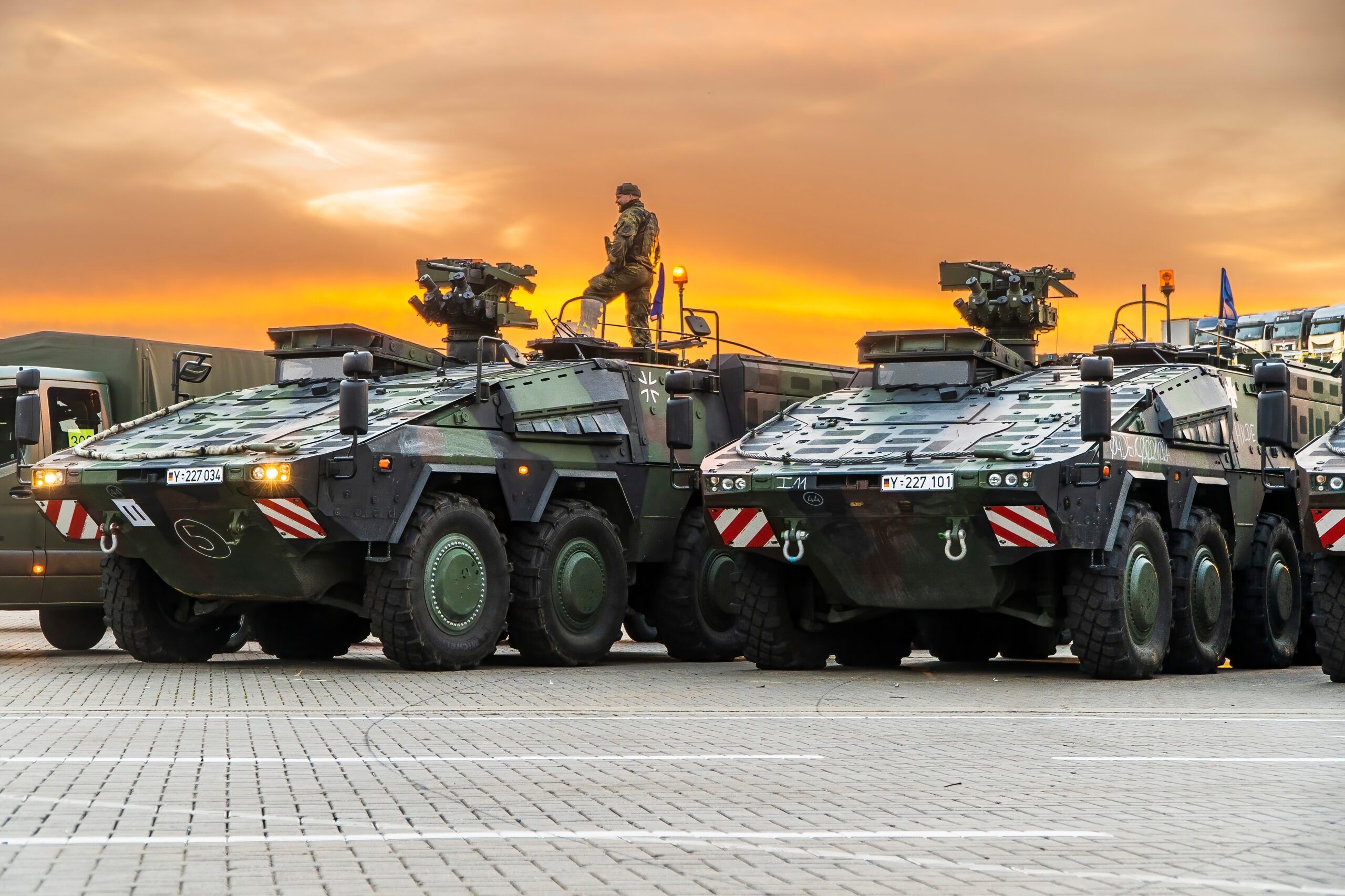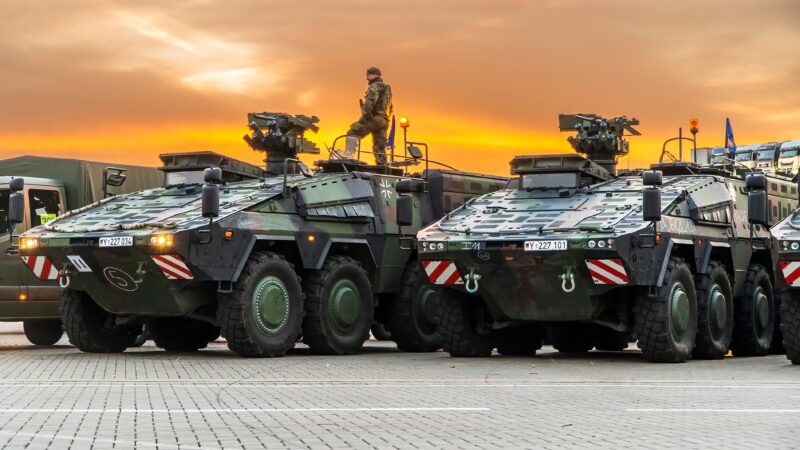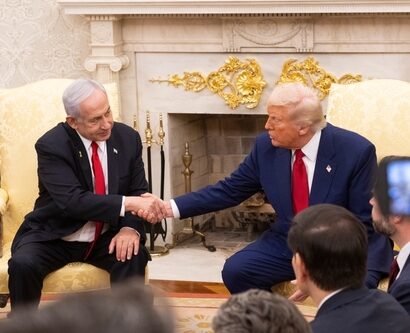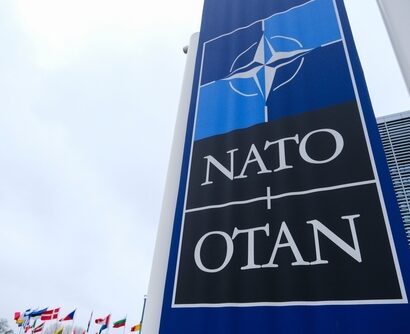Abstract: The German Army’s Medium Forces are crucial in maintaining the principles of Manoeuvre Warfare and the “Manoeuvrist Approach”. Their mobility, flexibility, and rapid deployment capabilities make them essential for NATO’s defence strategy, particularly on the eastern flank. These forces bridge the gap between light infantry and heavy armoured units, providing a versatile response to diverse threats. While challenges in logistics and adaptability exist, the Medium Forces represent a strategic asset in ensuring NATO’s readiness and deterrence against potential adversaries. Their development underscores the importance of adaptability and innovation in contemporary military operations.
Problem statement: How can the German Army ensure that its Medium Forces maintain high mobility and operational effectiveness in diverse environments, particularly on NATO’s eastern flank, while addressing the logistical and adaptability challenges under prolonged, high-tempo conditions to uphold NATO’s defence posture and Manoeuvre Warfare effectiveness?
So what?: If the German Army cannot effectively address the logistical and adaptability challenges faced by its Medium Forces, NATO’s ability to respond rapidly and effectively to threats on the eastern flank may be compromised. This could weaken the Alliance’s overall defence posture, reduce deterrence against potential adversaries, and undermine the effectiveness of Manoeuvre Warfare as a cornerstone of alliance strategy.

Source: shutterstock.com/Karolis Kavolelis
Introduction
The war in Ukraine has reignited debates about the viability of traditional military doctrines, particularly Manoeuvre Warfare. The war in Ukraine is marked by intense, static, and attritional warfare, which seems at odds with dynamic, mobility-focused strategies. However, dismissing these concepts based solely on the ongoing war would be premature. Military theorists like Carl von Clausewitz have long recognised that each war is unique, adapting its form to the context, much like a chameleon changes its colour to blend with its surroundings. This principle remains vital when considering potential conflicts on NATO’s eastern flank, where the strategic environment demands flexibility, speed, and operational depth.[1]
Historical Context of Manoeuvre Warfare
Manoeuvre warfare originated in the early 20th century, beginning with the development of German Stoßtruppen (stormtrooper) tactics during the First World War. These specialised assault units employed infiltration techniques to bypass enemy strongpoints, aiming to penetrate deep into enemy lines and disrupt their command and control. This marked the beginning of a shift away from static trench warfare toward more fluid, dynamic operations. These tactics were further refined and evolved during the Second World War into the combined-arms doctrine commonly known as “Blitzkrieg”, which emphasised rapid, concentrated attacks that sought to paralyse enemy forces through speed and surprise, ultimately aiming for a swift, decisive victory without the need for prolonged attritional battles.
The success of Blitzkrieg during the early years of the Second World War was a testament to the effectiveness of mobility, speed, and surprise.[2] However, this success was also heavily reliant on specific conditions: relatively open terrain, the availability of mechanised forces, German air superiority, and an adversary unprepared for such tactics. The Luftwaffe played a crucial role in providing close air support and disrupting enemy movements, which allowed ground forces to advance rapidly. As the war progressed, however, the limitations of Blitzkrieg became apparent, particularly when faced with fortified positions, the logistical challenges of sustaining rapid advances over extended fronts, and the eventual loss of air superiority.[3]
The success of Blitzkrieg during the early years of the Second World War was a testament to the effectiveness of mobility, speed, and surprise.
In the immediate aftermath of the war, military doctrines shifted towards a focus on nuclear deterrence and static defence, especially in the context of the early Cold War’s emphasis on preventing large-scale invasions through mutually assured destruction. However, as the nuclear stalemate solidified, conventional warfare doctrines reemerged as key to NATO’s strategy, with the concept of Manoeuvre Warfare evolving, particularly within NATO later in the Cold War. Faced with the numerical superiority of Warsaw Pact forces, NATO planners emphasised the need for flexibility and mobility to counter potential Soviet advances.
In the 1960s and 1970s, NATO began to prioritise conventional forces once again, and doctrine development gradually returned to the principles of mobility and flexibility. This was a response to the Warsaw Pact’s numerical superiority, leading NATO planners to emphasise rapid deployment, mechanised forces, and mobile defence strategies. By the 1980s, this evolution culminated in the development of the “AirLand Battle” doctrine by the US Army. AirLand Battle integrated air and ground operations to disrupt enemy forces before they could mass for an attack, focusing on deep strikes against logistics, command, and control nodes behind enemy lines. This doctrine was built on the lessons of Blitzkrieg and the necessity of coordinated, multi-domain warfare to maintain the tactical initiative.[3]
This doctrine influenced NATO’s overall strategy, emphasising the importance of striking deep into enemy territory to disrupt logistics, command, and control.[4]
The Modern Relevance of Manoeuvre Warfare
Despite the resurgence of static warfare in Ukraine, Manoeuvre Warfare remains highly relevant in military doctrine, especially for NATO.[5] The current conflict has highlighted the dangers of attritional warfare, where high casualty rates and extensive material losses can lead to prolonged stalemates. Avoiding such a scenario is crucial for NATO—particularly in a potential conflict on its eastern flank. The Alliance cannot afford the political, economic, or human costs of a drawn-out war of attrition. Therefore, the principles of Manoeuvre Warfare—speed, flexibility, and exploiting operational opportunities—are essential; this is especially the case at the tactical and operational levels of war, where immediacy gives these attributes tremendous power.[6]
The principles of Manoeuvre Warfare are essential; this is especially the case at the tactical and operational levels of war, where immediacy gives these attributes tremendous power.
The war in Ukraine also underscores the importance of adaptability in military strategy. While the war has been marked by trench warfare and artillery duels reminiscent of the First World War, this does not mean future conflicts will follow the same pattern. NATO’s ability to adapt its tactics and strategies to the specific conditions of a conflict will be critical. This adaptability is a core element of the “Manoeuvrist Approach,” which emphasises the need to target the enemy’s vulnerabilities, particularly in their command and control structures, rather than engaging in a confrontation of forces.[7], [8]
The Role of Technology in Modern Manoeuvre Warfare
Technological advancements have influenced the evolution of Manoeuvre Warfare significantly. The development of precision-guided munitions, advanced surveillance and reconnaissance systems, and integrated command and control networks have enhanced the ability of military forces to execute rapid, decisive operations.[9] These technologies allow for a more precise application of force, reducing the need for massed formations and enabling smaller, more agile units to achieve strategic effects.[10] Additionally, network-centric operations allowed for dispersed command structures, meaning that the precise application of force on targets such as command nodes might, in some cases, prove futile—though still highly lethal. This dispersal complicates traditional targeting strategies, as eliminating key command points may not disrupt the overall operational effectiveness as anticipated in more centralised systems.
The German Army’s Medium Forces are a reflection of this trend. Equipped with the GTK Boxer and other advanced platforms, these forces are designed to operate in a networked environment, where real-time intelligence and rapid decision-making are crucial.[11] The mobility and protection offered by wheeled vehicles like the Boxer enable these forces to conduct rapid manoeuvres, exploit gaps in enemy defences, and respond to emerging threats with speed and flexibility.[12]
The mobility and protection offered by wheeled vehicles like the Boxer enable these forces to conduct rapid manoeuvres, exploit gaps in enemy defences, and respond to emerging threats with speed and flexibility.
Moreover, the integration of unmanned systems, both aerial and ground-based, into military operations has further expanded the capabilities of Manoeuvre Warfare.[13] Drones provide persistent surveillance, target acquisition, and even strike capabilities, enhancing commanders’ situational awareness and enabling them to make informed decisions on the battlefield.[14] This integration of manned and unmanned systems is likely to play a critical role in future conflicts, particularly in complex environments where traditional reconnaissance and surveillance methods may be limited.[15]
The German Army’s Medium Forces: A Strategic Asset
The creation of the German Army’s Medium Forces represents a strategic shift in how Germany plans to contribute to NATO’s collective defence. Traditionally, the German military has been known for its heavy armoured formations, which played a key role during the Cold War.[16] However, the specific challenges posed by the eastern flank of NATO for Germany, e.g. the distance of around 1500 kilometres to the possible front line, have necessitated the development of more flexible, mobile forces capable of rapid deployment and versatile operations for Germany.[17] It is worth mentioning that, therefore, other Allies along the Eastern flank will have to take over more responsibility regarding heavy forces.
Germany’s Medium Forces are designed to bridge the gap between light infantry, which is highly mobile but lacks protection and firepower, and heavy armoured units, which offer significant protection and firepower but are less mobile.[18] This balance makes the Medium Forces particularly suited to the operational environment of Eastern Europe, where rapid redeployment and the ability to operate in varied terrain—from open plains to urban areas—are critical.[19]
During the exercise SABER STRIKE 2024, the deployment of a Medium Forces battalion to the Suwalki Corridor demonstrated their strategic value.[20] Covering a distance of approximately 1,200 kilometres in just three days, these forces were able to position themselves in a critical area of NATO’s eastern flank, ready to respond to potential threats.[21] This rapid deployment capability is essential in a region where the time to react to potential aggression is limited and where the ability to project force quickly can be a decisive factor in deterring or defeating an adversary.[22]
NATO’s Strategic Posture on the Eastern Flank
NATO’s eastern flank, stretching from the Baltic States in the north to the Black Sea in the south, represents one of the most strategically sensitive areas for the Alliance.[23] The proximity to Russia, combined with the varying military capabilities of the countries in this region, presents a unique set of challenges. NATO’s strategy here has traditionally relied on a combination of forward presence—with multinational battlegroups stationed in Poland and the Baltic States—and the ability to reinforce these forces during a crisis rapidly.[24]
NATO’s eastern flank, stretching from the Baltic States in the north to the Black Sea in the south, represents one of the most strategically sensitive areas for the Alliance.
The role of the German Army’s Medium Forces in this context is crucial.[25] These forces provide a rapidly deployable, flexible response capability that can reinforce existing NATO units or act independently to delay, disrupt, or defeat an advancing enemy.[26] Their mobility allows them to operate across the breadth of the eastern flank, from the Suwalki Corridor to the plains of Romania, providing NATO commanders with a versatile tool to respond to a wide range of scenarios.[27]
Furthermore, the Medium Forces’ ability to conduct deep operations—striking at the enemy’s logistics, command and control, and other critical nodes—aligns with NATO’s broader strategy of deterrence and defence.[28] By threatening the enemy’s rear areas and disrupting their operational tempo, the Medium Forces can create opportunities for larger, follow-on forces to exploit, potentially shifting the balance of power in a conflict.[29]
Comparisons with Other NATO Countries
Germany is not the only NATO country adapting its military forces to the challenges of modern warfare.[30] Several other NATO members have also undertaken significant reforms to enhance their mobility, flexibility, and readiness.[31] For example, the US has been at the forefront of developing and implementing the Multi-Domain Operations (MDO) concept, which seeks to integrate operations across all domains—land, air, sea, space, and cyberspace—to create an overmatch against adversaries.[32]
The US has been at the forefront of developing and implementing the Multi-Domain Operations concept, which seeks to integrate operations across all domains to create an overmatch against adversaries.
The US Army’s modernisation efforts, particularly the development of new armoured vehicles, long-range precision fires, and enhanced command and control systems, reflect a commitment to maintaining a qualitative edge over potential adversaries.[33] The emphasis on multi-domain integration ensures that US forces can operate in contested environments, leveraging the strengths of each domain to achieve operational and strategic objectives.[34]
In contrast, the United Kingdom has focused on restructuring its military forces to enhance its expeditionary capabilities.[35] The creation of the British Army’s Strike Brigades, which are equipped with wheeled vehicles similar to Germany’s Medium Forces, is a key component of this strategy.[36] These brigades are designed to be rapidly deployable, capable of operating independently or as part of a larger formation, and able to conduct high-tempo operations across a wide range of environments.[37]
Scandinavian countries, particularly Sweden and Finland, have also prioritised mobility and flexibility in their defence planning.[38] Given their proximity to Russia and the complex terrain of the Nordic region, these countries have emphasised the importance of rapid mobilisation, territorial defence, and the ability to conduct operations in harsh, challenging environments.[39] The integration of conscript forces with professional units, combined with a focus on total defence—where the entire society is involved in national defence efforts—underscores the unique approach these countries have taken to address their security challenges.[40]
The Strategic Implications for NATO
The development of Medium Forces within the German Army and similar initiatives in other NATO countries highlight the Alliance’s recognition of the need for adaptable, flexible forces capable of operating in a complex and contested environment.[41] This shift is not just about enhancing military capabilities; it also has significant strategic implications for NATO as a whole.[42]
Firstly, the emphasis on mobility and rapid deployment enhances NATO’s deterrence posture.[43] The ability to quickly reinforce the eastern flank or respond to a crisis elsewhere in Europe sends a clear signal to potential adversaries that NATO is prepared and capable of defending its members.[44] This deterrence is further strengthened by the interoperability of forces within NATO, ensuring that units from different countries can operate seamlessly together in a coalition environment.[45]
Secondly, the focus on flexible, multi-role forces like the German Medium Forces allows NATO to address a broader range of threats.[46] While the primary concern remains state-based threats, particularly from Russia, NATO must also be prepared to respond to non-state actors, hybrid warfare, and other forms of conflict that may arise in the future.[47] The adaptability of Medium Forces makes them well-suited to these diverse challenges, providing NATO with a versatile tool for crisis management and conflict resolution.[48]
Challenges in Sustaining Medium Forces in Prolonged Operations
While the German Army’s Medium Forces offer significant advantages, sustaining them in prolonged operations presents several challenges.[49] One of the primary challenges is logistical support.[50] Maintaining operational readiness requires a robust supply chain, particularly in terms of fuel, ammunition, and spare parts.[51] In a high-tempo operational environment, ensuring that these supplies are available where and when needed can be difficult, especially when operating in areas with limited infrastructure.[52]
Maintaining operational readiness requires a robust supply chain, particularly in terms of fuel, ammunition, and spare parts.
Another challenge is maintaining the effectiveness of these forces in diverse environments.[53] While the Medium Forces are designed for flexibility, operating in extreme conditions requires specialised training and equipment.[54] The German Army must invest in the continuous training of its personnel and the adaptation of its equipment to ensure that the Medium Forces can operate effectively in any environment.[55]
Finally, the psychological and physical strain on personnel involved in high-tempo, high-mobility, and long-range operations cannot be underestimated.[56] The need for rapid redeployments, constant vigilance, and the demands of modern warfare place significant stress on soldiers.[57] The German Army will need to ensure that it provides adequate support to its personnel, including mental health services, rest periods, and measures to prevent burnout.[58]
Conclusion
By emphasising mobility, flexibility, and the ability to conduct rapid, decisive operations, German Medium forces are well-suited to the challenges of a potential conflict on NATO’s eastern flank.[59], [60] Their development reflects a broader recognition within NATO of the need to adapt to a changing security environment, where the ability to respond quickly and effectively to a wide range of threats is more important than ever.[61]
As NATO continues to evolve, the German Army’s Medium Forces will play a crucial role in maintaining the Alliance’s deterrence posture and ensuring that it remains capable of defending its members against any potential aggression.[62] However, the challenges of sustaining these forces in prolonged operations and ensuring their effectiveness in diverse environments must be addressed.[63] Through continuous investment in training, logistics, and technology, the German Army can ensure that its Medium Forces remain at the forefront of NATO’s collective defence efforts.[64]
The adaptability, speed, and operational depth provided by the Medium Forces are not just a tactical advantage; they are a strategic necessity in an era where the nature of conflict is increasingly complex and unpredictable.[65] As NATO faces the challenges of the 21st century, the German Army’s Medium Forces will be a key component in ensuring the Alliance’s ability to defend itself and its members, maintaining the principles of Manoeuvre Warfare and the “Manoeuvrist Approach” in the process.[66]
In the broader context of NATO’s strategy, the German Army’s Medium Forces symbolise the adaptability and innovation required to navigate the complexities of modern warfare.[67] They are a testament to the ongoing relevance of Manoeuvre Warfare and the “Manoeuvrist Approach” in a world where the only constant in conflict is change.[68]
Lieutenant-Colonel (GS) Sebastian Hagen is the Battalion Commander of the 1 Light Infantry Battalion (Jägerbataillon 1) of the German Army. Before this assignment, he was a desk officer in the German Federal Ministry of Defence, Policy Division and an Action Officer in NATO´s International Military Staff as well as the German Military Representation to EU and NATO. He was deployed to Afghanistan and Mali as a Platoon and Company Commander. His Master Thesis (Möglichkeiten und Grenzen der Analyse von hybriden Kriegen nach Clausewitz: Eine Analyse mit Fallstudie zum sogenannten Islamischen Staat (IS) was published in 2020 (ISBN 3346174921) The views contained in this article are the author’s alone and do not represent the views of the Federal Armed Forces of Germany.
[1] Carl von Clausewitz, On War, ed. and trans. Michael Howard and Peter Paret (Princeton: Princeton University Press, 1976), 89.
[2] Ian F. W. Beckett, Blitzkrieg: Myth, Reality, and Hitler’s Lightning War (New York: HarperCollins, 2015), 45.
[3] Dennis E. Showalter, Armor and Blood: The Battle of Kursk, The Turning Point of World War II (New York: Random House, 2013), 210.
[4] US Army Training and Doctrine Command (TRADOC), The US Army in Multi-Domain Operations 2028 (Fort Eustis: TRADOC, 2018), 25.
[5] Michael E. Lynch, “AirLand Battle: The Evolution of Deep Strike,” Parameters 35, no. 2 (2005): 54.
[6] Julian S. Corbett, Principles of Maritime Strategy (London: Longmans, Green and Co., 1911), 89.
[7] Trevor N. Dupuy, Understanding War: History and Theory of Combat (New York: Paragon House, 1987), 92.
[8] US Department of Defense, Multi-Domain Operations, Joint Doctrine Notes, no. 1 (2020): 10.
[9] Andrew F. Krepinevich, The Military-Technical Revolution: A Preliminary Assessment (Washington, DC: Center for Strategic and Budgetary Assessments, 2002), 8.
[10] Richard P. Hallion, Storm Over Iraq: Air Power and the Gulf War (Washington, DC: Smithsonian Institution Press, 1992), 123.
[11] Bundesministerium der Verteidigung, Weißbuch 2016: Zur Sicherheitspolitik und zur Zukunft der Bundeswehr (Berlin: Bundesministerium der Verteidigung, 2016), 65.
[12] Franz-Stefan Gady, “Germany’s Medium Forces and NATO’s Eastern Flank,” The Diplomat, July 20, 2019.
[13] David Hambling, “Drones and the Future of Warfare,” Wired, August 8, 2016.
[14] P. W. Singer, Wired for War: The Robotics Revolution and Conflict in the 21st Century (New York: Penguin, 2009), 132.
[15] Peter W. Singer and August Cole, Ghost Fleet: A Novel of the Next World War (New York: Houghton Mifflin Harcourt, 2015), 224.
[16] Christopher Bellamy, The Evolution of Modern Warfare (New York: Routledge, 2014), 184.
[17] Lawrence Freedman, The Transformation of Strategic Affairs (London: International Institute for Strategic Studies, 2006), 29; To contextualise why Medium Force’s mobility is crucial, we can look at the Cold War when NATO/the Bundeswehr had one Corps for 30 kilometres of the front. Today, this is the job of one battalion. Heavy forces are too slow and inflexible to respond to a dynamic and dispersed frontline. The situation is further complicated by a major change for Germany: the frontline is now 1500 km away! Compare this to the Cold War, when it was around 25 km – 50 for most Bundeswehr forces.
[18] James S. Corum, The Roots of Blitzkrieg: Hans von Seeckt and German Military Reform (Lawrence: University Press of Kansas, 1992), 155.
[19] Andrew J. Bacevich, The Pentomic Era: The US Army Between Korea and Vietnam (Washington, DC: National Defense University Press, 1986), 98.
[20] NATO, NATO Strategic Direction South Hub (Naples: NATO, 2020), 12.
[21] Bundeswehr, “Exercise Saber Strike 2024,” Bundeswehr Official Website, accessed June 2024.
[22] Bundeswehr, “GTK Boxer: All-Terrain Vehicle,” Bundeswehr Factsheet, 2022.
[23] NATO, Strategic Concept for the Defence and Security of the Members of the North Atlantic Treaty Organization (Brussels: NATO Public Diplomacy Division, 2010), 7.
[24] Seth G. Jones, A Coercive Turn in NATO’s Strategy (Washington, DC: CSIS, 2019), 45.
[25] Alexander R. Vershbow and Philip M. Breedlove, “Permanent Deterrence: Enhancements to the US Military Presence in North Central Europe,” Atlantic Council, January 2018.
[26] Heather A. Conley, “The Suwalki Corridor: NATO’s Vulnerable Spot in the East,” Center for Strategic and International Studies, February 2019.
[27] NATO, “NATO Enhanced Forward Presence,” NATO Factsheet, March 2021.
[28] Jonathan Marcus, “NATO’s Strategy for Deterrence and Defense,” BBC News, June 4, 2020.
[29] Kimberly Marten, Russia and NATO: A Strategic Imbalance (New York: Council on Foreign Relations, 2021), 92.
[30] Janne Haaland Matlary, European Union Security Dynamics: In the New National Interest (London: Palgrave Macmillan, 2009), 145.
[31] John J. Mearsheimer, The Tragedy of Great Power Politics (New York: W.W. Norton & Company, 2001), 253.
[32] Michael O’Hanlon, The Future of Land Warfare (Washington, DC: Brookings Institution Press, 2015), 108.
[33] US Army Training and Doctrine Command (TRADOC), The US Army in Multi-Domain Operations 2028, 34.
[34] Department of Defense, “Multi-Domain Operations,” Joint Doctrine Notes, no. 1 (2020): 18.
[35] United Kingdom Ministry of Defence, Army Doctrine Publication: Operations (London: Ministry of Defence, 2010), 48.
[36] Richard North, “British Army Strike Brigades,” UK Defence Journal, April 12, 2017.
[37] Alex Vershbow and Philip M. Breedlove, “Permanent Deterrence,” 38.
[38] Magnus Petersson, NATO and the Nordic Countries: The Defense Cooperation of Finland and Sweden (London: Routledge, 2021), 78.
[39] Anna Wieslander, “Sweden’s Defense Strategy,” Atlantic Council, June 16, 2020.
[40] Björn von Sydow, Swedish Defense Policy (Stockholm: Government Offices of Sweden, 2019), 22.
[41] NATO, NATO 2030: United for a New Era (Brussels: NATO Public Diplomacy Division, 2020), 13.
[42] Jamie Shea, Keeping NATO Strong in a Complex World (Brussels: NATO Defense College, 2021), 47.
[43] Henry Kissinger, World Order (New York: Penguin Press, 2014), 128.
[44] NATO, NATO Enhanced Forward Presence, 7.
[45] Lawrence Freedman, Deterrence (London: Polity, 2004), 189.
[46] Anthony H. Cordesman, The Search for Stability: Strategic Developments in the Eastern Mediterranean (Washington, DC: CSIS, 2020), 72.
[47] Kimberly Marten, Russia and NATO: A Strategic Imbalance, 102.
[48] Heather A. Conley, “The Suwalki Corridor,” 39.
[49] Lawrence Freedman, The Future of War: A History (London: Penguin Press, 2017), 248.
[50] NATO, Logistics in NATO Operations (Brussels: NATO Standardization Office, 2020), 34.
[51] Christopher Bellamy, The Evolution of Modern Warfare, 212.
[52] David A. Shlapak, Reinforcing Deterrence on NATO’s Eastern Flank (Santa Monica: RAND Corporation, 2016), 58.
[53] Richard P. Hallion, Storm Over Iraq, 123.
[54] Bundesministerium der Verteidigung, GTK Boxer: All-Terrain Vehicle, 2022.
[55] US Army Training and Doctrine Command (TRADOC), The US Army in Multi-Domain Operations 2028, 67.
[56] Alex Vershbow and Philip M. Breedlove, “Permanent Deterrence,” 42.
[57] NATO, Strategic Concept for the Defence and Security of the Members of the North Atlantic Treaty Organization, 27.
[58] Anthony H. Cordesman, The Search for Stability, 82.
[59] Seth G. Jones, A Coercive Turn in NATO’s Strategy, 65.
[60] Trevor N. Dupuy, Understanding War: History and Theory of Combat, 103.
[61] Richard North, “British Army Strike Brigades,” 27.
[62] Jamie Shea, Keeping NATO Strong in a Complex World, 51.
[63] NATO, “NATO Enhanced Forward Presence,” 17.
[64] Bundeswehr, “Exercise Saber Strike 2024.”
[65] Michael O’Hanlon, The Future of Land Warfare, 122.
[66] Janne Haaland Matlary, European Union Security Dynamics, 160.
[67] NATO, NATO 2030: United for a New Era, 19.
[68] Lawrence Freedman, The Future of War, 273.






